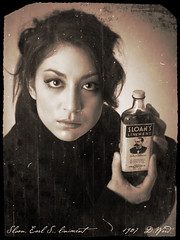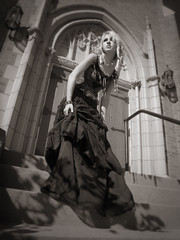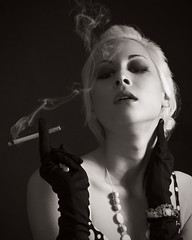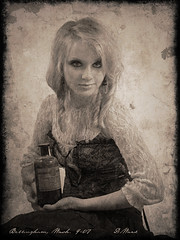Sunday, May 31, 2009
Friday, May 29, 2009
Tuesday, May 26, 2009
Monday, May 25, 2009
Sunday, May 24, 2009
Saturday, May 23, 2009
Monday, May 18, 2009
Exposed! A second interview with Dave Ward Photography
Hot on the heels of my first interview, I was asked for another interview. This interview was conducted by Dani.
 In the position you now hold, what do you do on a typical day?
In the position you now hold, what do you do on a typical day?
As an independent, part-time professional photographer, I'm currently very free to focus on whatever I choose from day-to-day. I work a "day job" during weekdays, so both shoots and development/post-production all take place on evenings and weekends.
On the evening of a shoot, prep time is usually fairly quick -- 30-45 minutes to set up lights, change backgrounds, swap new batteries into the main flash, make sure memory cards are cleared and ready, etc. Once the model arrives, she may or may not take more prep time for her hair and makeup, and then we get right down to shooting. Most shoots last between 30 minutes and 2 hours, but have been as short as 15 minutes or as long as an entire day. Once the model leaves, I break down the lights and other equipment, and download the shots to the hard drive. Post-production usually takes several days, sometimes a week or more. I create rough JPEGs of all shots in Adobe Lightroom and select the shots I will finish from those. To create the finished shots, I usually return to the RAW file and process it in Photoshop. Photomatic Pro has also just entered my workflow in the last few weeks when a bit of HDR is called for. Finished shots are uploaded to my flickr account (except when prohibited by the client) and sent to the client. The best shots are also uploaded to my Facebook, MySpace and Model Mayhem accounts, and added to my professional website's online portfolio at my own domain.
What are the most interesting aspects of your job?
Developing my "eye" is very interesting, and I'm always fascinated by anything that shows me that I see the world differently.
And although it's cliché, the people are definitely the most interesting. When I went from photographing alleys and plants to photographing people, I was a very asocial person -- introverted and a bit hermit-like. I'm still mostly like that, but photographing people has forced me to become more social that I ever dreamed I would be. I've made some wonderful contacts and even real friends through this work, and have learned how to "come out of my shell."
What part of your work do you consider dull or repetitious?
While shooting is always exciting and fascinating (I often break into a sweat and get an adrenaline rush), developing and post-production can be mind-numbing sometimes. When I was a little kid my father taught me how to develop black and white film and then make prints from the negatives. Seeing an image "bloom" under the red safelight never lost its magic, but my workflow is entirely digital now and digital developing doesn't have the same excitement and magic. It's made up for by the incredible control and precision we have when working digitally. But the sense of "magic" you get from seeing the image materialize in the chemical tray isn't there.
What percentage of your time must you devote to this activity?
I'm not full-time professional yet -- I still work a day job -- so the percentage is nowhere near what I hope it will eventually be. I'm also devoted to my girlfriend, so I keep plenty of time for "us." It's very easy to get on the computer and spend an entire evening working on images, but I try not to let it take over too much of what spare time I have. It's hard to guess what percentage I spend, but it's currently rather small, as I set photography on the back burner for the last few months and am only just now starting to arrange some new shoots and get things moving again. Late last year, when I was shooting more normally and regularly, I was probably spending 25% of my time on photography, which is a great deal considering that about 45% of my time is already spent on my day-job and commuting. During the last few months I've spent less than 10% of my time on photography. That will be changing quickly.
 What specific field do you work in?
What specific field do you work in?
Commercial fashion and high fashion, and editorial/art photography.
Are there any specific courses a student might take that would be particularly beneficial in this field?
I never had formal training -- I learned from my father when I was a kid, and then learned the rest on my own. However I can say that while I neglected photography during my school & college years, I was a very prolific and passionate art student. I did tons of drawings with pencil, ink, colored pencils, airbrush and other media, and worked as a newspaper illustrator and cartoonist in the early 1990s. All those years of art trained my eye and taught me composition, use of tone, subject selection, and other basic skills. When I got back into photography in the early 2000s, those skills were already well developed. The basic skills of art are the same for all the visual arts.
What entry level jobs qualify one for this field?
I work as an independent photographer, but if you want to get hired for a photography job you can start out by serving as an assistant for another working photographer. Get to know the local photographers who shoot weddings, and let them know you would like to be their assistant for a shoot. You'll probably wind up doing very simple jobs like carrying equipment, holding reflectors and baffles, or herding bridesmaids, but once you assist at just one shoot, you've got resumé fodder and you've got your foot in the door.
What aspects of a career in this field do you consider particularly good? Particularly bad?
Photography is a very rewarding creative outlet and you get to meet and work with fantastic people. The feedback you get on your work can be fantastic. And for an independent photographer, it's just amazing when you get an email completely out of the blue from somebody you've never heard of who wants to license a photo for an ad campaign, annual report or brochure.
On the downside, photography is not a steady field. If you shoot weddings and high school portraits, you'll have some busy spells and long stretches of nothing -- and the thin wallet that comes with those times; the business is a constant toggle between boom and bust. If you work for a studio as an employed photographer, the threat of layoffs and downsizing is always a possibility. If you shoot stock photography, well, stock is an incredibly bloated market so it's extremely hard to make a living in that field. And if you're a photojournalist, the work might be steady, but newspapers are currently in a long, continuing slump that has been happening for years and will certainly continue. Photojournalists also have to fear downsizing, plus the hard fact that the newspaper market is in a long contraction. Photography is a hard business, and is not stable, reliable work.
What special advice would you give to a young person entering this field?
Shoot a lot (always in RAW mode!) and save all of it. Your morgue file is valuable; you never knew when you might be able to sell a shot you took years ago. Don't expect fame and glory; do the work because you are passionately driven to do it, not because you think it will make you wealthy. And always shoot photos that are pleasing to yourself; if you are shooting to please others and not yourself, it will show through. Be authentic, and don't take pictures that you don't love.
 What inspires you to do photography?
What inspires you to do photography?
The need for a creative outlet.
When I was 8 years old (1977) I discovered that I could draw better than most kids, and I focused my creative energy on drawing from then until the mid-1990s. I worked for a while as a newspaper illustrator and cartoonist. In the mid-90s, my physical energy was starting to sag. I also realized around that time that although I was good enough at drawing to impress most people, I wasn't good enough to have the kind of career in drawing that I wanted -- an illustrator or professional cartoonist. But more pressing, I just didn't have the physical energy that it takes to keep drawing at the prolific rate I always had. I more or less gave up drawing in the mid-90s, and didn't have any creative outlet for years. In the early 2000s I got my first digital camera, and rediscovered photography. At first I just took the type of personal "life-documenting" snapshots that everybody takes. Gradually realized that the fact that I no longer had to pay for film and wasn't limited to rolls of 12, 24 or 36 shots meant I was liberated to experiment without feeling like I was wasting anything; I could literally afford to waste shots. So I began paying attention to composition, tones, visual texture and so on. In the fall of 2004 I discovered the website flickr.com, which was at that time a small startup website operating out of Vancouver, B.C. I posted a batch of photos on flickr at the end of October, and started receiving feedback. I just plunged headfirst into serious photography at that point, and photography replaced drawing as my creative outlet.
I always needed a creative outlet like a boiling pot with a lid needs a steam vent. I don't know how I survived the years after I stopped drawing and before I rediscovered photography!
Photography is not something I want to do -- now it's something I have to do.
 What is your favorite subject to shoot? I know this chances from time to time, but what is it right now?
What is your favorite subject to shoot? I know this chances from time to time, but what is it right now?
I mostly work with models. I used to shoot a lot of subjects and would swing through various interests in phases, but once you find your specialty -- the thing that you really excel at -- the other subjects naturally fall to the back burner and become "hobby subjects" while your specialty becomes the center of your serious efforts.
A have a lot of really fantastic models. Ruby Hardt is one; she's an alternative fashion model who focuses on rockabilly styled clothing and has a brilliant smile like a spotlight. "Miss Cat" is another; it's a shame she isn't pursuing modeling more seriously, as she's a classic mainstream beauty and the camera loves her. But my "primo" model -- my most perfect creative collaborator -- is Bridgette Colette; she always brings a whole list of fantastic ideas to every shoot, and nails each and every one of them easily and beautifully. We also seem to work together on a near telepathic level, as she does what I'm about to ask just before I say it.
How do you decide which shot to use out of the entire selection from a photo shoot?
It can be a big task, since I typically shoot hundreds of photos in a session. First I create what I call JPEG "rough mixes" from the RAW files in Adobe Lightroom. Then I open all the shots from a particular pose or scene in Preview (the standard image viewing application on the Macintosh) and start flipping through them. I'll select the best shots that way. Often I'll narrow it down to two or three shots, and then just flip back and forth between those shots until I start seeing little imperfections in one of the shots. Once I choose the shot I want to finish, I usually label it (under File > Label on the Mac). I often choose the shots I'll finish, and then start processing the selections, so labeling helps me remember which ones were best.
How do you know when a piece is finished?
I wish there was a simple answer I could explain, but when you're working on a photo, there is a certain feeling you get when it's finished. It's a feeling of satisfaction and completion; if you have ever done a jigsaw puzzle, then it's the same feeling you get when you put the last piece in and step back and look at the finished puzzle. You have to learn to pay attention to that feeling. Don't stop working on the photo until it "clicks" as finished, but also don't keep working on it once you get that feeling.
 Describe what you think your style is.
Describe what you think your style is.
Much of my commercial photography can be summed up fairly in the word "clean." There are a lot of qualities I try to put into my photos, but at least regarding the commercial work, the word "clean" sums up a trait my work has that makes it stand apart from most others.
On the other hand, my art photography is often dirty, gritty, visually a bit messy -- multiple textures stacked up with different lighting modes, one ore more vignettes, and often even a layer of dust that I scanned from some old mistreated negatives I took when I was a kid. I can spend hours essentially destroying a photo with grit, grime and garbage -- but destroying it in a way that I think and hope makes it uniquely beautiful and compelling. I can understand the pictoralists like Anne Brigman who poured chemicals on their finished prints and then smeared and scratched them with their hands to make them look like paintings. In art you sometimes are at your most creative when you appear to be "destroying" your work.